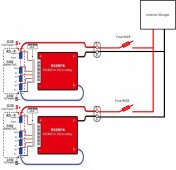crossy
Solar Addict
Our 6.5kWP grid-tie solar is working fine, it just sits on the car-port and offsets our bill nicely.
Note that we are located in sunny Thailand so regulations are somewhat more relaxed than many are used to.
Our grid tie is currently net-metering (spinning the conventional disc meter backwards when exporting) which is technically illegal but there are many thousands of small systems doing just that.
In the words of our local PEA (the electricty authority) supervisor "if the meter reader doesn't see it going backwards ..." (eye, heart, grief)
Of course the engineer in my head is bored, I'm looking at "hybridising" the system whilst at the same time adding more solar capacity thus alleviating the "risk" of net metering here. This would also add a degree of "UPS" functionality and reduce the necessity for our (noisy) genset.
A hybrid system of course needs batteries which are the subject of this thread (discussion applies equally for those going totally off-grid too).
I can assemble 100Ah packs of 32650 cells for about the same cost as single 100Ah (golf cart) cells.
So, which is better, using single 100Ah LiFePO4 cells or the "Tesla" method of using multiple 5Ah cells?
A few thoughts:-
Note that we are located in sunny Thailand so regulations are somewhat more relaxed than many are used to.
Our grid tie is currently net-metering (spinning the conventional disc meter backwards when exporting) which is technically illegal but there are many thousands of small systems doing just that.
In the words of our local PEA (the electricty authority) supervisor "if the meter reader doesn't see it going backwards ..." (eye, heart, grief)
Of course the engineer in my head is bored, I'm looking at "hybridising" the system whilst at the same time adding more solar capacity thus alleviating the "risk" of net metering here. This would also add a degree of "UPS" functionality and reduce the necessity for our (noisy) genset.
A hybrid system of course needs batteries which are the subject of this thread (discussion applies equally for those going totally off-grid too).
I can assemble 100Ah packs of 32650 cells for about the same cost as single 100Ah (golf cart) cells.
So, which is better, using single 100Ah LiFePO4 cells or the "Tesla" method of using multiple 5Ah cells?
A few thoughts:-
- Smaller cells cost less each, so gradual expansion of the pack can be done on an "available funds" basis.
- Smaller cells should allow for better cooling.
- The big cells need less effort to assemble packs.
- Failure of a single small cell just removes a small chunk of capacity, loss of a big cell removes a big chunk (or even the whole pack).



